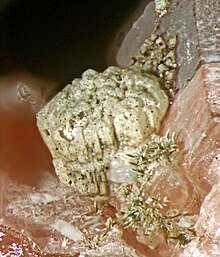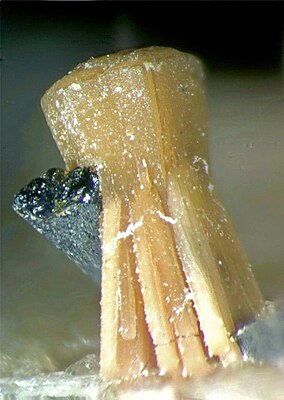Rhabdophan
| Rhabdophan | |
|---|---|
| Rhabdophan (Ce) on analcime with a black, broken aegirin crystal on the side of Mont Saint-Hilaire , Québec , Canada | |
| General and classification | |
| chemical formula | (Ce, La, Nd) [PO 4 ] · H 2 O (mixed crystal formula) |
|
Mineral class (and possibly department) |
Phosphates, arsenates, vanadates - water-containing phosphates without foreign anions |
|
System no. to Strunz and to Dana |
8.CJ.30 ( 8th edition : VII / C.29) 04/40/07/01 (Ce), 04/40/07/02 (La), 04/40/07/03 (Nd) |
| Crystallographic Data | |
| Crystal system | hexagonal |
| Crystal class ; symbol | hexagonal trapezoidal; 622 |
| Space group | P 6 2 22 (No. 180) |
| Lattice parameters | see crystal structure |
| Formula units | Z = 3 |
| Physical Properties | |
| Mohs hardness | 3 to 3.5 |
| Density (g / cm 3 ) | 3.9 to 4 |
| Cleavage | no |
| Break ; Tenacity | uneven to scalloped |
| colour | brown, light pink, yellowish white, cream, light green |
| Line color | White |
| transparency | translucent |
| shine | Resin gloss to matt |
| Crystal optics | |
| Refractive indices |
n ω = 1.654 (-La) to 1.688 (-Ce) n ε = 1.703 (-La) to 1.744 (-Ce) |
| Birefringence | δ = 0.049 (-La) to δ = 0.056 (-Ce) |
| Optical character | uniaxial positive |
Rhabdophan (also rhabdophanite ) is the collective name for unspecified minerals of the gapless mixed crystal series with the end members rhabdophan (Ce) , rhabdophan (La) and rhabdophan (Nd) from the mineral class of " phosphates , arsenates and vanadates ".
All minerals crystallize in the hexagonal crystal system with the chemical composition (Ce, La, Nd) [PO 4 ] · H 2 O (mixed crystal formula). The following compositions apply to the individual minerals:
- Rhabdophan (Ce) : Ce [PO 4 ] · H 2 O
- Rhabdophan (La) : (La, Ce) [PO 4 ] • H 2 O
- Rhabdophan (Nd) : (Nd, Ce) [PO 4 ] • H 2 O
Rhabdophan mostly develops stalactitic, spherical or kidney-shaped masses, but also radial aggregates of amber-brown color and shiny wax surfaces. Light pink, yellowish white and cream colored rhabdophanes were also found.
Etymology and history
The word Rhabdophan is a combination of the Greek words ῥάβδος [rhábdos] for rod or rod, and φαίνεσθαι [phainesthai] for appearing, showing oneself and referring to the typical pattern in the light spectrum of minerals.
A first description of rhabdophan, but still without the appendix of the predominant rare earth metal in the formula, was made in 1878 by William G. Lettsom. It was not until later analyzes that it was found that rhabdophan is a mixture of three very similar minerals. Therefore, the original rhabdophan with an overhang of cerium received the appendix - (Ce).
Rhabdophan (La) was first described by George J. Brush and Samuel L. Penfield in 1883 and got its name due to the predominance of lanthanum in the formula and its close relationship to rhabdophan (Ce).
Rhabdophan (Nd) was described in 1957 by FA Hildebrand, MH Carron and HJ Rose, Jr., which owes its name to the predominance of neodymium in the formula.
The type locality for Rhabdophan (Ce) is the copper mine "Fowey Consols" (Tywardreath, Par Parish) near St Austell in the English county of Cornwall and the type locality for Rhabdophan (La) and Rhabdophan (Nd) is the " Salisbury Iron Mines ”in the English county of Wiltshire in the United Kingdom.
classification
Already in the now outdated, but still common 8th edition of the mineral classification according to Strunz , the rhabdophanes belonged to the mineral class of "phosphates, arsenates and vanadates" and there to the department of "water-containing phosphates without foreign anions ", where they were named after the "rhabdophan" Group "with the system no. VII / C.29 and the other members Brockit , Grayit , Ningyoit and Tristramit .
The 9th edition of Strunz's mineral systematics , which has been in effect since 2001 and is used by the International Mineralogical Association (IMA), also classifies the rhabdophanes in the category of “phosphates etc. without additional anions; with H 2 O “. However, this is further subdivided according to the relative size of the cations involved , so that the minerals are classified in the subsection “J. Only with large cations ”can be found, where they are also named after the“ rhabdophan group ”with the system no. 8.CJ.45 and the other members Brockit, Grayit, Ningyoit, Smirnovskit and Tristramit.
The systematics of minerals according to Dana , which is mainly used in the English-speaking area , assigns the rhabdophane to the class of "phosphates, arsenates and vanadates" and there in the department of "water-containing phosphates etc.". Here you are the namesake of the " Rhabdophangruppe " with the system no. 04/40/07 and the other members Brockit, Grayit and Tristramit can be found in the subsection of "Water-containing phosphates etc., with A 3+ XO 4 × x (H 2 O)".
Crystal structure
All rhabdophanes crystallize hexagonally in the space group P 6 2 22 (space group no.180) and with three formula units per unit cell , but with slightly different lattice parameters :
- Rhabdophane- (Ce) with a = 7.01 Å and c = 6.40 Å
- Rhabdophan (La) with a = 7.03 Å and c = 6.41 Å
- Rhabdophan (Nd) with a = 6.96 Å and c = 6.37 Å
Modifications and varieties
Rhabdophan (Pb) is considered a leaded variety of rhabdophan (Ce).
Education and Locations

Rhabdophane relatively rare form in some hydrothermal ore - deposits . Accompanying minerals include barite , chalcopyrite , fluorite , sphalerite and tetrahedrite .
As a rather rare mineral formation, rhabdophan has so far (status: 2011) only been found at a few sites or only in small numbers. A total of around 100 sites are known to be known, about half of which are Rhabdophan- (Ce) and around 10 sites each are Rhabdophan- (La) and Rhabdophan- (Nd).
Common sites for all three end links are among others in Germany, more precisely near Gengenbach and Oberwolfach in the Black Forest and in Russia on the Kola peninsula .
Various rhabdophans can also be found in Australia, Belgium, Burundi, China, Greenland, Japan, Canada, Malawi, Norway, Pakistan, Spain, the Czech Republic, Ukraine, Hungary and the United States.
See also
literature
- Friedrich Klockmann : Klockmann's textbook of mineralogy . Ed .: Paul Ramdohr , Hugo Strunz . 16th edition. Enke , Stuttgart 1978, ISBN 3-432-82986-8 , pp. 626 (first edition: 1891).
- John W. Anthony, Richard A. Bideaux, Kenneth W. Bladh, Monte C. Nichols: Rhabdophane- (Ce). In: Handbook of Mineralogy, Mineralogical Society of America. 2001 ( handbookofmineralogy.org PDF 62.5 kB).
- John W. Anthony, Richard A. Bideaux, Kenneth W. Bladh, Monte C. Nichols: Rhabdophane- (La). In: Handbook of Mineralogy, Mineralogical Society of America. 2001 ( handbookofmineralogy.org PDF 61.3 kB).
- John W. Anthony, Richard A. Bideaux, Kenneth W. Bladh, Monte C. Nichols: Rhabdophane- (Nd). In: Handbook of Mineralogy, Mineralogical Society of America. 2001 ( handbookofmineralogy.org PDF 65.9 kB).
Web links
- Mineral Atlas: Rhabdophan (Wiki)
- Mindat - Rhabdophane (English)
- Webmineral - Rhabdophane- (Ce) , Rhabdophane- (La) and Rhabdophane- (Nd)
Individual evidence
- ↑ a b c d e f g h Hugo Strunz , Ernest H. Nickel: Strunz Mineralogical Tables . 9th edition. E. Schweizerbart'sche Verlagbuchhandlung (Nägele and Obermiller), Stuttgart 2001, ISBN 3-510-65188-X , p. 489 .
- ↑ a b Handbook of Mineralogy - Rhabdophane- (Ce) and Rhabdophane- (La) (see literature link)
- ↑ Mindat - Rhabdophane- (Ce) and Rhabdophane- (La) (see web links)
- ↑ William G. Lettsom: On rhabdophane, a new mineral. In: Journal of Crystallography, Mineralogy and Petrography. Volume 3, Leipzig 1878, p. 191 ( Textarchiv - Internet Archive ).
- ↑ William G. Lettsom: On rhabdophane, a new mineral. (1878) In: Phil. Mag. Volume 13, 1882, pp. 527-529 ( ebooksread.com )
- ↑ Mindat - Total number of locations for rhabdophan
- ↑ Number of localities for Rhabdophan- (Ce)
- ↑ Number of localities for Rhabdophan- (La)
- ↑ Number of localities for Rhabdophan- (Nd)
